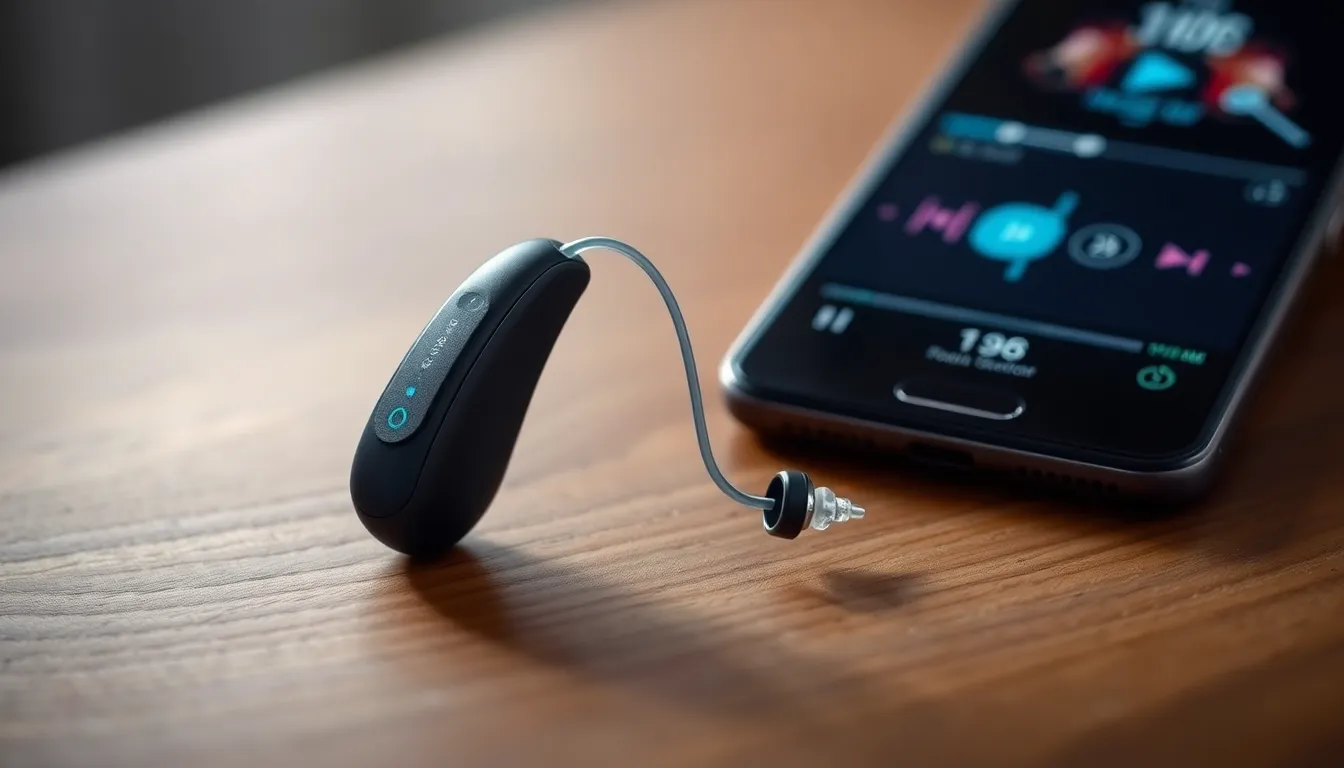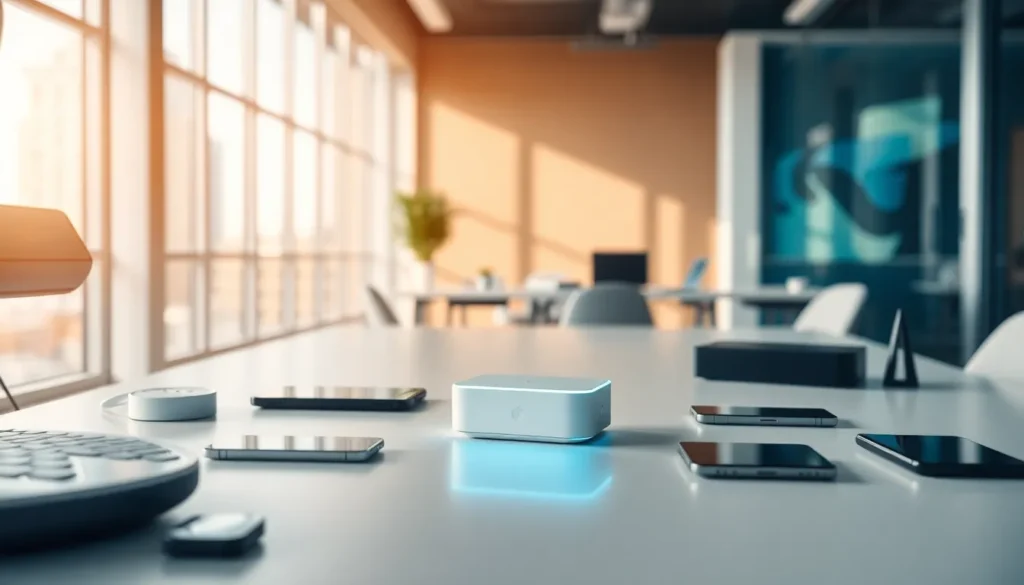Table of Contents
ToggleIn a world where everyone seems to be shouting over each other, smart hearing aids are like the cool kids at the party who actually know how to listen. Gone are the days of bulky devices that scream “I can’t hear you!” These sleek gadgets are designed to enhance the sounds of life while filtering out the noise, making conversations feel as effortless as a Sunday morning.
Imagine being able to adjust your hearing aid with a tap on your smartphone, all while looking effortlessly stylish. Smart hearing aids not only amplify sound but also adapt to different environments, turning the cacophony of life into a symphony. Whether it’s the laughter of friends or the subtle rustle of leaves, these devices help users reconnect with the world around them, proving that hearing well is just as important as looking good.
Overview of Smart Hearing Aids
Smart hearing aids represent a significant advancement in auditory technology. Users enjoy enhanced sound quality through sophisticated algorithms that tailor amplification to individual needs. Features often include Bluetooth connectivity, enabling seamless integration with smartphones and other devices. These functionalities allow for direct streaming of calls and music.
Advanced noise-cancellation systems effectively differentiate between speech and background sounds. Innovative sensors adjust settings automatically based on the environment, which enhances user comfort and clarity. Many smart hearing aids offer companion apps for easy control and personalization of settings.
Some models include health monitoring features, tracking physical activity and providing alerts. Users can receive real-time feedback about their hearing aid performance, allowing for timely adjustments. Smart hearing aids cater to diverse listening scenarios, from quiet conversations to bustling cafes.
For example, users might switch to a specific program when entering a noisy restaurant. Many brands prioritize design, ensuring these aids are discreet while looking stylish. Smart hearing aids contribute to improved social interactions and overall quality of life for users.
The Bluetooth functionality extends battery life by optimizing usage, connecting to compatible devices without draining power. Accessibility features are also included, enabling voice commands for hands-free operation. Individuals can further personalize their experience through various color and style options available in the market.
Smart hearing aids not only keep pace with technological progress but also significantly enhance daily living for users. This dynamic approach fosters a sense of connection to both people and environments, underscoring the importance of hearing health.
Features of Smart Hearing Aids

Smart hearing aids incorporate various advanced features designed to enhance user experience and improve hearing quality.
Connectivity Options
Bluetooth connectivity stands out as a critical feature, allowing users to link their hearing aids to smartphones and other devices. Streaming phone calls, music, and audio directly into the hearing aids creates a seamless auditory experience. Some models even support multiple device pairing, which facilitates easy switching between various audio sources. Wi-Fi compatibility enhances the user experience by enabling updates and settings adjustments. Furthermore, compatibility with smart home devices fosters a more integrated lifestyle.
Sound Quality Enhancements
Sophisticated algorithms significantly enhance sound quality in smart hearing aids. Automatic adjustments occur based on environmental sounds, ensuring clarity whether in quiet spaces or busy cafes. Noise-cancellation technologies distinguish speech from background noise, facilitating natural conversations. Personalized sound profiles cater to individual listening preferences, thus improving overall satisfaction. User-friendly apps provide additional control over sound settings, enabling fine-tuning of frequency response. Advanced directional microphones further refine the listening experience by focusing on sounds directly in front of the user, thus enhancing speech recognition and comprehension.
Benefits of Smart Hearing Aids
Smart hearing aids offer numerous advantages for users, significantly enhancing their auditory experience and daily interactions.
Improved Hearing Experience
Enhanced sound quality distinguishes smart hearing aids from traditional devices. Algorithms provide personalized amplification tailored to individual hearing profiles. Users enjoy conversations in noisy environments thanks to advanced noise-cancellation systems. High-definition sound reproduction ensures clarity during discussions. Directional microphones capture speech more effectively, improving dialogue understanding. Users report feeling more engaged and connected with their surroundings. Health tracking features provide insights into listening habits and activity levels. This combination of clarity and customization contributes to an overall better hearing experience.
User-Friendly Interface
Smart hearing aids feature intuitive interfaces that promote ease of use. Many devices connect to smartphones via Bluetooth, simplifying control through dedicated apps. Adjusting sound settings becomes effortless with user-friendly controls. Users can manage volume levels and sound profiles directly from their smartphones. Notifications about battery life and performance provide added convenience. Streaming calls and music directly into hearing aids enhances everyday experiences. Frequent updates from manufacturers improve functionality, ensuring users have access to the latest technology. This overall user-centric approach makes smart hearing aids accessible and enjoyable for all ages.
Types of Smart Hearing Aids
Smart hearing aids come in various forms, each designed to meet specific user needs. Two popular types include behind-the-ear models and in-the-ear models.
Behind-the-Ear Models
Behind-the-ear (BTE) models sit comfortably behind the ear, making them discreet yet effective. These devices often accommodate larger batteries, which provide extended usage times. Enhanced connectivity features enable direct audio streaming from smartphones, televisions, and other devices. Sound processing in BTE models is powerful, allowing for improved noise cancellation and clarity. Users appreciate the durability of these designs, as they often resist moisture and dust. BTE models cater to a wide range of hearing loss levels, offering versatile options for users with varying needs.
In-the-Ear Models
In-the-ear (ITE) models fit snugly within the outer ear, providing a more invisible option for users. A compact design allows ITE models to comfortably house essential technology, including advanced microphones and amplifiers. Customization is a key advantage; these devices can be molded to fit the unique contours of an individual’s ear. Generally, ITE models provide excellent sound quality with natural hearing experience. Users often enjoy the convenience of easy insertion and removal. These models suit individuals with mild to moderate hearing loss, emphasizing aesthetic appeal and comfort.
Smart hearing aids have transformed the way individuals experience sound and interact with their environments. By combining advanced technology with user-friendly designs, these devices offer unparalleled sound quality and connectivity. With features tailored to individual needs, users can enjoy a more engaging auditory experience.
The evolution from traditional hearing aids to smart models highlights the importance of hearing health in daily life. As users embrace these innovations, they not only enhance their communication but also improve their overall well-being. Smart hearing aids represent a significant leap forward in auditory technology, making them an essential tool for anyone seeking to reconnect with the world around them.




